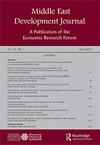Who can work from home in MENA?
IF 0.9
Q4 DEVELOPMENT STUDIES
引用次数: 0
Abstract
ABSTRACT The COVID-19 pandemic has had a profound impact on the world economy. The need for social distancing, lockdowns, or complete curfews has meant that this impact varied significantly across segments of society. Those unable to work remotely, or who work in settings necessitating close contact with others faced a trade-off between their lives and livelihoods. This trade-off was especially pronounced early on during the pandemic when vaccines had not yet been developed, hospitals were overwhelmed and governments were resorting to strict social distancing measures to mitigate the impact on their already strained healthcare systems. In this study, I examine the extent to which jobs can be successfully performed remotely in five MENA countries: Algeria, Egypt, Jordan, Palestine and Tunisia. I develop a teleworkability index using micro data on occupational characteristics. I find that relatively few jobs in MENA countries are compatible with teleworking and this share varies considerably by industry, gender, age and the formality of employment. I further investigate the ability to work from home in practice by considering the digital divide (a lack of reliable access to vital tools for teleworking, such as a personal computer and reliable internet access) as well as actual work from home behavior during the pandemic using real time surveys. I find that even for those who have high telework potential only few have access to computer and internet. Surveys conducted during the pandemic suggest that our measure of teleworkability was quite close to actual work from home behavior in each country.在中东和北非谁可以在家工作?
摘要新冠肺炎疫情对世界经济产生了深远影响。保持社交距离、封锁或完全宵禁的必要性意味着,这种影响在社会各阶层之间差异很大。那些无法远程工作或在需要与他人密切接触的环境中工作的人面临着生活和生计之间的权衡。这种权衡在疫情早期尤为明显,当时疫苗尚未研发出来,医院不堪重负,政府正采取严格的社交距离措施来减轻对本已紧张的医疗系统的影响。在这项研究中,我考察了中东和北非地区五个国家(阿尔及利亚、埃及、约旦、巴勒斯坦和突尼斯)远程工作的成功程度。我利用职业特征的微观数据开发了一个远程工作指数。我发现,在中东和北非地区国家,与远程工作兼容的工作相对较少,这一比例因行业、性别、年龄和就业形式而异。我通过考虑数字鸿沟(缺乏可靠的远程工作重要工具,如个人电脑和可靠的互联网接入)以及疫情期间在家工作的实际行为,利用实时调查进一步调查了在家工作在实践中的能力。我发现,即使是那些有很高远程工作潜力的人,也只有少数人能使用电脑和互联网。疫情期间进行的调查表明,我们对远程工作能力的衡量与每个国家在家工作的实际行为非常接近。
本文章由计算机程序翻译,如有差异,请以英文原文为准。
求助全文
约1分钟内获得全文
求助全文

 求助内容:
求助内容: 应助结果提醒方式:
应助结果提醒方式:


